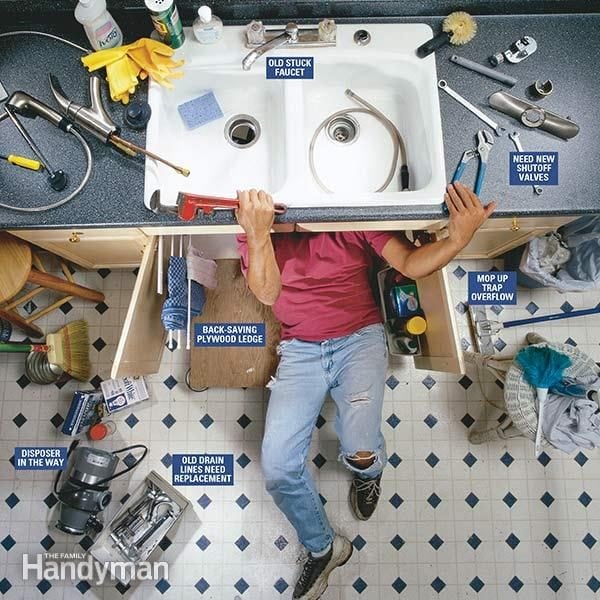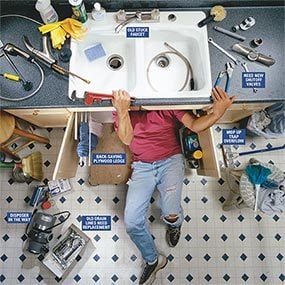


Lots of useful tips and step-by-step advice on how to install a new kitchen faucet, including how to avoid common problems.
![]()
Time
![]()
Complexity
![]()
Cost
The toughest part of replacing a kitchen faucet is removing the old one. Unexpected problems always pop up-corroded pipes, difficult-to-reach nuts and poor access to fittings. Otherwise, installing a new kitchen faucet isn't tough at all. Actually, the directions that come with your new faucet are probably all you'll need to do that part of the job. Barring unforeseen problems, you could be washing up under the faucet in an hour or so. This article walks you through a basic replacement process and tells you how to get through those tough parts.
Whether you’re looking for a simple upgrade for aesthetic reasons or have a sink desperately needing repair, it’s always good to know how to change a kitchen faucet.
Plan on replacing your faucet during store hours. There’s a chance you’ll need to make more than one trip to the hardware store for parts as you learn how to change your particular kitchen faucet. To give yourself a fighting shot at completing the job with one-stop shopping, consult this list:
If you need to remove drain lines to access the faucet, get a pipe wrench or slip-joint pliers. For cutting copper tubes, buy a conventional tubing cutter. But if your copper supply lines are within a few inches of the back of the cabinet, buy a special mini tube cutter. You’ll also need a set of open-end wrenches for disconnecting and hooking up the water lines.
When you’re buying a faucet, as with most other things, you get what you pay for. Faucets that cost less than $100 may be made of chrome-plated plastic arts with seals and valves that wear. They’re okay for light-duty use but won’t stand up long in a frequently used kitchen sink.
Faucets that cost more than $100 generally have solid brass bodies with durable plating and washerless controls that’ll give leak-free service for many, many years. Some even come with a lifetime warranty. Quality continues to improve up to about $200. Spend more than $200, and you’re mostly paying for style and finish. Sticking with popular brands will mean replacement parts will be easier to find.
With most faucets, only three of the four holes are covered, so you’ll either need to get a blank insert or use the extra hole for a liquid soap or instant hot water dispenser.
Prop up a scrap of plywood on some 1-qt. paint cans in front of the cabinet. You’ll be much more comfortable lying under the sink. Otherwise, the edge of the cabinet would be digging into your back
After you pull out all of the cleansers, buckets and old vases from under the sink, go ahead and lie under there and see if you can easily access the faucet. If so, go right to Step Three. If not, it’s time to start dismantling the things blocking your path.
Most likely, the main obstacles will be the pipes and P-traps that drain the sinks. Don’t be afraid to pull them out, but more importantly, don’t be afraid to replace them with new ones. If you have older, chrome-plated drain lines, the pipe walls may be so corroded that they’ll crush in the jaws of a pipe wrench or slip-joint pliers. After you remove them, throw all the parts in a box to match them exactly at the store later. If you have plastic drain parts, be careful during removal—you’ll probably be able to reuse them.
Before disconnecting the drain lines, take a snapshot or sketch the layout to help you put it all back together. Then, disconnect the drain lines and P-traps if they block your access to the faucet and water supply pipes. Place a bucket or coffee can under the P-trap to dump residual water after you pull it free.

Sometimes, a garbage disposer can be a 20-lb. roadblock. Don’t be discouraged—it’s easier than you think to remove it and then reinstall it after the faucet is in.
Unplug the garbage disposer, or shut off the circuit breaker in the main service panel if the disposer is directly wired.

TMB STUDIO
Disconnect the dishwasher discharge line and place a 1-gal. paint can under the garbage disposer with some rags on top to cushion the disposer when it drops free. Release the disposer by tapping the retaining ring with a hammer in a counterclockwise direction.